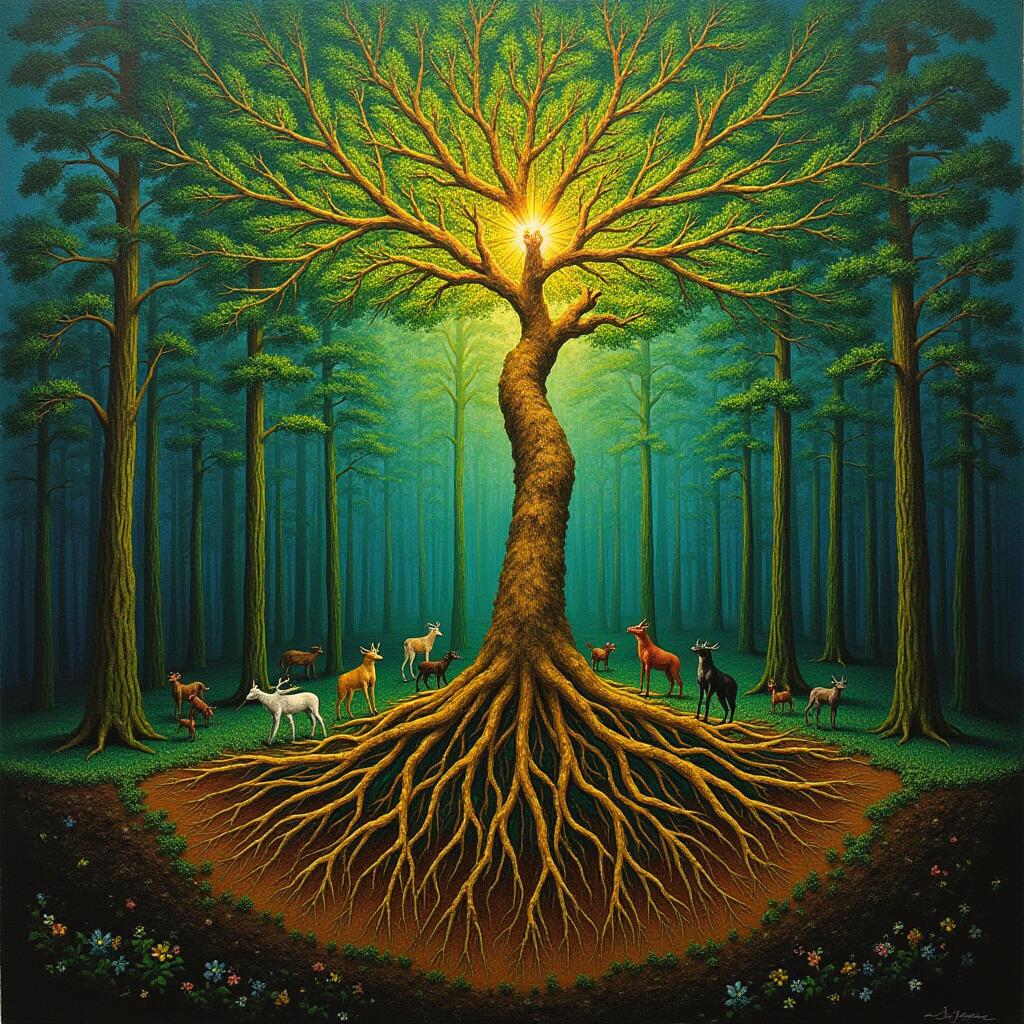SamuelGabrielSG on Nostr: A World Teeming with Consciousness: Linking Plant, Animal, and Human Intelligence ...
A World Teeming with Consciousness: Linking Plant, Animal, and Human Intelligence
Introduction
In recent years, discoveries in the natural world have begun to blur the lines between what we traditionally consider as intelligence and consciousness. From the intricate communication networks of plants to the complex social behaviors of animals, evidence suggests that intelligence and communication are not exclusive to humans. As we deepen our understanding of these phenomena, a compelling picture emerges—one that points to a world teeming with consciousness, where life forms across the spectrum interact, adapt, and thrive through their unique forms of intelligence and communication.
Plant Intelligence and the Wood Wide Web
Plants have long been viewed as passive organisms, reacting to their environment in simple, predictable ways. However, the discovery of the Wood Wide Web—a vast underground network of roots and mycorrhizal fungi—has revolutionized this perception. Through this network, plants communicate with one another, sharing resources, sending warning signals, and even supporting weaker neighbors. This form of distributed intelligence, where plants respond to environmental cues and engage in complex interactions, challenges the notion that intelligence requires a brain or nervous system.
Plants' ability to share resources with struggling neighbors or to send signals warning of insect attacks suggests a level of awareness and responsiveness that can be seen as a form of consciousness, albeit different from animal or human consciousness. The Wood Wide Web reveals that plants are active participants in their ecosystems, engaging in behaviors that ensure their survival and the health of the community around them.
Animal Intelligence and Communication
While plant intelligence might seem surprising, the intelligence and communication skills of animals are more widely recognized. Animals exhibit a range of behaviors that indicate high levels of intelligence—tool use in primates, problem-solving in birds, and complex social structures in mammals. Animals communicate through vocalizations, body language, and even chemical signals, conveying information about everything from mating opportunities to dangers in their environment.
For example, dolphins are known for their sophisticated communication abilities, including the use of signature whistles to identify themselves, which can be likened to the use of names among humans. Elephants, too, demonstrate deep social bonds and communicate over long distances through low-frequency sounds. These behaviors show that animals are not merely driven by instinct but are capable of complex thought processes, emotions, and social interactions.
When we consider the communication networks of animals alongside those of plants, we begin to see a continuum of intelligence that spans across life forms. Both plants and animals engage in behaviors that require perception, decision-making, and interaction with others in their environment—traits traditionally associated with consciousness.
Human Consciousness: The Pinnacle or Part of a Spectrum?
Human consciousness is often viewed as the pinnacle of intelligence, characterized by self-awareness, abstract thinking, and the ability to communicate complex ideas. However, as we explore the intelligence and communication abilities of plants and animals, it becomes increasingly clear that human consciousness is part of a broader spectrum of awareness and interaction that permeates life on Earth.
Human consciousness allows us to reflect on our experiences, make choices based on ethical considerations, and envision future possibilities. But when we examine the behaviors of plants and animals, we see that these life forms, too, engage in actions that promote their survival and the well-being of their communities. Whether it’s a tree sharing nutrients with a sapling through the Wood Wide Web, or a wolf pack coordinating a hunt, these behaviors reflect a level of awareness and interaction that resonates with our understanding of consciousness.
A World Teeming with Consciousness
The evidence of plant and animal intelligence and communication challenges us to expand our definition of consciousness beyond the human experience. It suggests that consciousness is not a binary attribute, possessed by humans alone, but rather a spectrum that encompasses the entire living world.
When we recognize that plants communicate and respond to their environment in sophisticated ways, and that animals exhibit behaviors driven by thought, emotion, and social interaction, we begin to see consciousness as a fundamental aspect of life. This realization invites us to view the Earth not as a collection of individual organisms, but as a web of interconnected beings, each contributing to the flow of life in its own unique way.
Conclusion
The discovery of plant intelligence and communication, alongside the well-documented intelligence of animals, points to a world that is alive with consciousness. While human consciousness allows for the highest levels of reflection and abstraction, it is not an isolated phenomenon. Instead, it is part of a vast spectrum of awareness that stretches across the natural world.
As we deepen our understanding of this interconnected web of life, we are called to appreciate the richness of consciousness that surrounds us. From the silent communications of trees to the social bonds of animal societies, the evidence is all around us: we live on a planet teeming with life, intelligence, and awareness. Recognizing this interconnected consciousness can inspire a greater sense of respect and responsibility towards the world we share, reminding us that we are part of a vibrant, living Earth.

Introduction
In recent years, discoveries in the natural world have begun to blur the lines between what we traditionally consider as intelligence and consciousness. From the intricate communication networks of plants to the complex social behaviors of animals, evidence suggests that intelligence and communication are not exclusive to humans. As we deepen our understanding of these phenomena, a compelling picture emerges—one that points to a world teeming with consciousness, where life forms across the spectrum interact, adapt, and thrive through their unique forms of intelligence and communication.
Plant Intelligence and the Wood Wide Web
Plants have long been viewed as passive organisms, reacting to their environment in simple, predictable ways. However, the discovery of the Wood Wide Web—a vast underground network of roots and mycorrhizal fungi—has revolutionized this perception. Through this network, plants communicate with one another, sharing resources, sending warning signals, and even supporting weaker neighbors. This form of distributed intelligence, where plants respond to environmental cues and engage in complex interactions, challenges the notion that intelligence requires a brain or nervous system.
Plants' ability to share resources with struggling neighbors or to send signals warning of insect attacks suggests a level of awareness and responsiveness that can be seen as a form of consciousness, albeit different from animal or human consciousness. The Wood Wide Web reveals that plants are active participants in their ecosystems, engaging in behaviors that ensure their survival and the health of the community around them.
Animal Intelligence and Communication
While plant intelligence might seem surprising, the intelligence and communication skills of animals are more widely recognized. Animals exhibit a range of behaviors that indicate high levels of intelligence—tool use in primates, problem-solving in birds, and complex social structures in mammals. Animals communicate through vocalizations, body language, and even chemical signals, conveying information about everything from mating opportunities to dangers in their environment.
For example, dolphins are known for their sophisticated communication abilities, including the use of signature whistles to identify themselves, which can be likened to the use of names among humans. Elephants, too, demonstrate deep social bonds and communicate over long distances through low-frequency sounds. These behaviors show that animals are not merely driven by instinct but are capable of complex thought processes, emotions, and social interactions.
When we consider the communication networks of animals alongside those of plants, we begin to see a continuum of intelligence that spans across life forms. Both plants and animals engage in behaviors that require perception, decision-making, and interaction with others in their environment—traits traditionally associated with consciousness.
Human Consciousness: The Pinnacle or Part of a Spectrum?
Human consciousness is often viewed as the pinnacle of intelligence, characterized by self-awareness, abstract thinking, and the ability to communicate complex ideas. However, as we explore the intelligence and communication abilities of plants and animals, it becomes increasingly clear that human consciousness is part of a broader spectrum of awareness and interaction that permeates life on Earth.
Human consciousness allows us to reflect on our experiences, make choices based on ethical considerations, and envision future possibilities. But when we examine the behaviors of plants and animals, we see that these life forms, too, engage in actions that promote their survival and the well-being of their communities. Whether it’s a tree sharing nutrients with a sapling through the Wood Wide Web, or a wolf pack coordinating a hunt, these behaviors reflect a level of awareness and interaction that resonates with our understanding of consciousness.
A World Teeming with Consciousness
The evidence of plant and animal intelligence and communication challenges us to expand our definition of consciousness beyond the human experience. It suggests that consciousness is not a binary attribute, possessed by humans alone, but rather a spectrum that encompasses the entire living world.
When we recognize that plants communicate and respond to their environment in sophisticated ways, and that animals exhibit behaviors driven by thought, emotion, and social interaction, we begin to see consciousness as a fundamental aspect of life. This realization invites us to view the Earth not as a collection of individual organisms, but as a web of interconnected beings, each contributing to the flow of life in its own unique way.
Conclusion
The discovery of plant intelligence and communication, alongside the well-documented intelligence of animals, points to a world that is alive with consciousness. While human consciousness allows for the highest levels of reflection and abstraction, it is not an isolated phenomenon. Instead, it is part of a vast spectrum of awareness that stretches across the natural world.
As we deepen our understanding of this interconnected web of life, we are called to appreciate the richness of consciousness that surrounds us. From the silent communications of trees to the social bonds of animal societies, the evidence is all around us: we live on a planet teeming with life, intelligence, and awareness. Recognizing this interconnected consciousness can inspire a greater sense of respect and responsibility towards the world we share, reminding us that we are part of a vibrant, living Earth.

